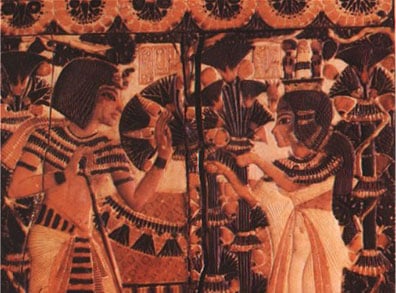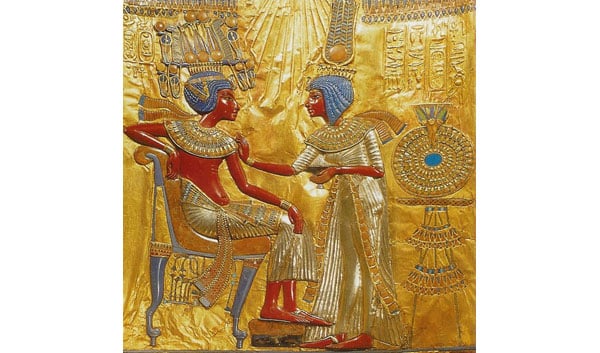The tragedy of Queen Ankhesenamun, sister and wife of Tutankhamun
Everyone has heard of the famous boy king, Tutankhamun, but the name of his beloved sister and wife Ankhesenamun is rarely uttered. The tragic life of Ankhesenamun was well documented in the ancient reliefs and paintings of the reign of her parents, the pharaoh Akhenaten and his great royal wife Nefertiti, until the death of Tutankhamun when the young queen seems to have disappeared from the historical records.
Ankhesenamun ("Her Life is of Amun") was a queen of the Eighteenth Dynasty of Egypt. She was the third of six known daughters, and became the great royal wife of her half-brother Tutankhamun when he was just 8 to 10 years old and she was 13. It is possible that she was briefly married to Tutankhamun's successor, Ay, believed by some to be her maternal grandfather. It has also been posited that she may have first been the wife of her father, Akhenaten.

Tutankhamun receives flowers from Ankhesenamun. This image is on the lid of a box found in Tut's tomb. Photo source: Wikipedia
Marriage within family was not uncommon in ancient Egypt and was practiced among royalty as a means of perpetuating the royal lineage. In fact, Tutankhamun’s parents had also been brother and sister, resulting in some of the genetic conditions that the boy king suffered, including a cleft palate and club foot. The pharaohs believed they were descended from the gods and incest was seen as acceptable so as to retain the sacred bloodline.
Ankhesenamun was born in a time when Egypt was in the midst of an unprecedented religious revolution (c. 1348 BC). Her father had abandoned the old deities of Egypt in favour of the one ‘true’ god of Aten (the Sun disc), thereby creating the first monotheistic religion. His revolutionary actions weren’t taken easily by the priesthood and the Egyptians followers of Ra. It was difficult for such a traditional culture to reject their old gods, and the priesthood—which held a great deal of power—put up a fierce resistance.
Ankhesenamun had two older sisters – Meritaten, Meketaten – and together, the three of them became the "Senior Princesses" and participated in many functions of the government and religion. Various reliefs found in Egypt appear to suggest that Akhenaten may have attempted to father children with all three of his eldest daughters, the second of whom seems to have died during child birth (this scene is depicted inside a royal tomb).
After the death of her father, Akhenaten, and following the short reigns of his successors, Smenkhkare and Neferneferuaten, Ankhesenamun became the wife of Tutankhamun. Following their marriage, the couple were quick to restore the old religion, disregarding Akhenaten’s actions.
Although both Tutankhamun and Ankhesenamun were still children, together they ruled Egypt for the next ten years. During their reign, history shows that Tutankhamun had an official adviser named Ay who most likely was the grandfather of Ankhesenamun, and who probably played an influential role in the lives and decisions of the young couple.
During their reign, it is believed that Tutankhamun and Ankhesenamun conceived two children (both girls) who were born prematurely and died. Evidence comes from the mummified remains of two babies found in Tutankhamun’s tomb and DNA analysis confirmed that they were daughters of Tutankhamun. One of the children is known to have had a condition called Spengel’s deformity in conjunction with spina bifida and scoliosis.
At about the age of eighteen or nineteen, Tutankhamun died suddenly, leaving Ankhesenamun alone without an heir in her early twenties. The grieving queen would have to continue in her official capacity as queen of Egypt and play a major role in finding a successor.
An inscribed ring and gold foil fragments found in the Valley of the Kings depict Ankhesenamen together with her husband’s successor, Ay, but there is no clear indication that they were married. Her name never appeared within his tomb and it is believed that she may have died during or shortly after Ay’s reign, as she disappears from history shortly after his period.
It is not known where she was buried, and no funerary objects with her name are known to exist. This leaves the possibility that her tomb is still somewhere out there, waiting to be discovered. This may help to unravel the final fate of Ankhesenamun.
Featured image: A gold plate found in Tutankhamun’s tomb depicting Tutankhamun and Ankhesenamen together.
References
Ankhesenamen – Encyclopaedia Britannica
Queen Ankhesenamen – by Anneke Bart
Ankhesenamen – Princeton.edu
Ankhesenamen – Ancient History Encyclopaedia


















Comments
I enjoyed reading the article above and I hope the information below is helpful to anyone who reads it! :)
There is a more recent study/theory that King Tut died in battle from a horse-drawn chariot. It is believed that King Tut suffered a fatal blow from the chariot wheel, crushing many ribs and his pelvic bone. The impact from the chariot wheel was said to be strong enough to severely damage the heart and lungs, so much so that the heart would not be recognizable to the embalmers. Hence, King Tut was mummified without one of the most vital organs to ensure a satisfactory afterlife. In addition, the theory suggest that King Tut was not buried in his own tomb, which would have been in preparation since his adolescence, but rather buried in his vizier's tomb- Ay. Ay is documented for being buried in another tomb much larger, more grandeur, and non-representative of his life as vizier nor King. The tomb, that Ay's mummy was said to be found, portrayed many hieroglyphs of the Boy Kings life. As far as the marriage between Ankhesenamun and Ay, supposedly the ring that archeologist found entails of a marriage between the two after the death of King Tut. Ankhesenamun did disappear from a lot of ancient Egyptian history but some scholars believe she outlived Ay's four year reign. There might be evidence to suggest that there is another burial tomb in the Valley of the Kings, at a depth deeper than King Tut's tomb. I enjoyed reading the article above and I hope the information below is helpful to anyone who reads it!
- The majority of the information above was obtained from a documentary titled
"Secrets of the Dead: Ultimate Tut"
provided by pbs.org
narrated by Jay O Sanders
produced by Blink Films
Well you can certainly believe whatever you want to, just be aware that real history isn't taught by conjecture or opinion but by observation of the known facts, and the known facts in the mummified remains of Tutankhamen no longer support a murder claim.
They are related. They share the same bloodline. They're both from royal blood ties. Ankhe, ay and tut are from the same lineage. I think tut and ankhe was killed.
If he was the grandfather of Ankhesenamun does not mean he would have been Pharoh. He was the Vicere for Tutankhamun and upon his death he was the most senior and highest official left from Tutankhamun's reign.This being said means he had knowledge of the State and coffers of the Empire. After he died Horenheb the General of Tutankhamun's reign took control of the throne.
Ay is believed to be her MATERNAL grandfather, and though they were half-brother/sister, they do not share the same mother. They did have the same father Pharoah Akhenaton.
Ay can therefore be her grandfather (on her mothers side) but also not King Tutankhamun's grandfather
Pages